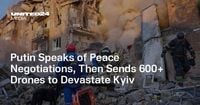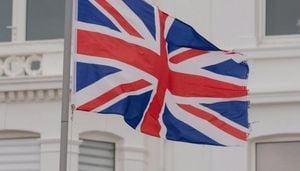As the sun rose over Kyiv on August 28, 2025, the city bore fresh scars from one of the most devastating Russian missile and drone barrages since the full-scale invasion began over three years ago. At least 21 people lost their lives—including children and teenagers—while dozens more were injured as hundreds of aerial weapons rained down on Ukraine's capital, shattering the uneasy calm that had followed a brief diplomatic thaw earlier in the month.
According to Reuters and Suspendine, firefighters worked through the rubble of destroyed apartment blocks and office buildings, pulling bodies from the debris. The EU delegation’s office and the British Council in Kyiv were among the civilian structures damaged in the overnight assault, which Kyiv officials described as the city’s deadliest since the start of the war. The Ukrainian Air Force reported that 629 drones and missiles were launched, including more than 500 Shahed drones—making this the second-largest attack since the invasion began in February 2022.
“This is Russia’s idea of peace. Terror and barbarism,” French President Emmanuel Macron declared in a statement, echoing the outrage felt across Europe. German Chancellor Friedrich Merz condemned the attack “in the strongest possible terms,” while UK Prime Minister Keir Starmer accused Russian President Vladimir Putin of “killing children and civilians, and sabotaging hopes of peace.” European Commission President Ursula von der Leyen, whose delegation’s offices were struck, called on Putin to “come to the negotiating table” and insisted that “we must secure a just and lasting peace for Ukraine with firm and credible security guarantees.”
The destruction extended far beyond the capital. Railway infrastructure was targeted, with a high-speed passenger train destroyed and other facilities damaged. The strikes came after a ten-day lull in large-scale bombardments, a pause that had followed a flurry of high-level diplomatic meetings involving US President Donald Trump, President Putin, Ukrainian President Volodymyr Zelenskyy, and European leaders in Alaska and Washington. For a moment, there was hope that the violence might subside. But as UNITED24 Media reported, that hope was dashed by the renewed onslaught.
This latest escalation unfolded against a backdrop of renewed, but increasingly fraught, diplomatic maneuvering. According to Suspilne, the Kremlin has proposed a new format for negotiations, demanding security guarantees, recognition of certain regional borders, and a clear timetable for Ukrainian disarmament. Kyiv, however, has insisted that “concrete, verifiable steps from Russia are needed before any reciprocal dialogue at the highest level can begin.”
In response to the strikes, President Zelenskyy announced that his top advisers, Andriy Yermak and Rustem Umerov, would travel to New York for talks with US envoy Steve Witkoff and members of Trump’s team. The aim: to discuss US mediation in future negotiations and to seek security guarantees for Ukraine. These talks are expected to take place in the coming weeks or months, depending on how the situation on the ground evolves.
Yet, as Bloomberg and DW noted, no direct talks between Zelenskyy and Putin have been scheduled. German Chancellor Merz observed that “it was obvious” a face-to-face summit was not forthcoming, despite prior assurances from the United States. White House Press Secretary Karoline Leavitt said President Trump was “not happy” and “not surprised” by the latest Russian attack, adding, “These are two countries that have been at war for a very long time.” Trump is expected to make an additional statement on the crisis, though the White House has already signaled skepticism about the prospects for immediate negotiations.
The diplomatic impasse is not for lack of trying. Since Trump’s return to the White House in January 2025, there has been a renewed push for a ceasefire. In late February, Zelenskyy visited Washington, but the meeting ended in acrimony. The US briefly suspended military aid in March, hoping to pressure Kyiv into a 30-day ceasefire, but Russia refused, insisting that the “root causes” of the conflict be addressed first. In May, Russia unilaterally declared a three-day ceasefire, and subsequent talks in Istanbul led to prisoner exchanges but little else. Two more rounds of negotiations in June and July also failed to yield a lasting peace.
In August, Trump hosted Putin for a historic summit in Alaska. The meeting was described as “productive” by Trump, but ultimately proved inconclusive, with no deals signed. Later that month, European leaders backed Zelenskyy’s return to the White House, urging the US to provide firm security guarantees and to reject any territorial concessions to Russia. Despite these efforts, the barrage on August 28 made clear that Moscow was not prepared to halt its campaign.
The international response has been swift and forceful. The US State Department approved an $825 million arms sale to Ukraine, including 3,350 ERAM Extended Range Attack Munition missiles capable of striking targets up to 400 kilometers away. According to DW, Ukraine will use funding from NATO allies Denmark, the Netherlands, and Norway, in addition to US military financing, to pay for the new weapons. However, the US Defense Department has blocked Ukraine from using US-made ATCAMS missiles to strike inside Russian territory, a move likely intended to prevent further escalation.
Meanwhile, the European Union announced it would summon Russia’s envoy over the attack on Kyiv, and President von der Leyen pledged to apply “maximum pressure” on Moscow, promising a new round of “hard biting sanctions” and efforts to use frozen Russian assets to support Ukraine’s defense and reconstruction. “The Kremlin will stop at nothing to terrorize Ukraine, blindly killing civilians—men, women, and children—and even targeting the EU,” von der Leyen said at a press conference in Brussels.
Turkey’s President Recep Tayyip Erdogan has also offered to facilitate high-level peace talks, emphasizing Ankara’s willingness to help bolster Ukraine’s security after a peace deal is reached. While previous rounds of negotiations in Istanbul led to prisoner exchanges, substantive agreements on a ceasefire or peace settlement have remained elusive.
For Ukrainians, the events of August 28 are a grim reminder of the stakes. As rescue workers combed through the wreckage in Kyiv, the head of the city’s military administration, Timur Tkachenko, confirmed that four children were among the dead. The death toll could still rise as more victims are found beneath the ruins.
Despite the devastation, Ukraine has reiterated its readiness to negotiate, provided that Russia demonstrates genuine intent through tangible actions. With the world watching, the coming weeks will reveal whether the renewed diplomatic push can break the deadlock—or whether, as so many fear, the violence will continue to spiral.





